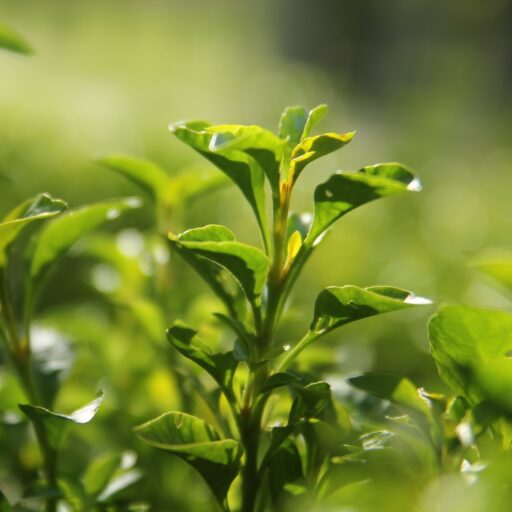Support our educational content for free when you purchase through links on our site. Learn more
Growing Teas Indoors: A Comprehensive Guide to Cultivating Your Own Tea [2024] 🍵
Quick Answer:
Looking to bring the tranquility of a tea garden into your home? With our comprehensive guide, you’ll learn everything you need to know about growing teas indoors. From choosing the right plants to setting up your indoor tea garden and caring for your plants, we’ve got you covered. Get ready to cultivate your own tea and enjoy the soothing benefits of a homegrown cup of tea!
Quick Tips and Facts:
- Indoor tea gardens are a popular way to bring nature indoors and create a serene atmosphere.
- Mint, chamomile, lemon balm, lavender, and rosemary are popular tea plants for indoor cultivation.
- Containers with proper drainage, well-draining potting mix, and 4-6 hours of sunlight or grow lights are essential for successful indoor tea gardening.
- Maintain temperatures between 60-75°F and humidity levels of 50-60% for optimal plant growth.
- Regular pruning, fertilizing, and organic pest control methods are key to caring for your indoor tea garden.
- Experiment with brewing times and temperatures to find your perfect cup of tea.
Background: The Joy of Growing Teas Indoors

Imagine stepping into your own personal tea garden, surrounded by lush greenery and the soothing aroma of freshly brewed tea. Growing teas indoors allows you to create a tranquil oasis right in your own home. Whether you’re a tea enthusiast or simply looking to add some greenery to your space, cultivating your own tea plants can be a rewarding and therapeutic experience.
At Growing Teas™, we’re passionate about tea and have years of experience in tea cultivation. In this comprehensive guide, we’ll share our expertise and provide you with all the information you need to start your own indoor tea garden. From choosing the right plants to caring for them, we’ll guide you every step of the way. So, let’s dive in and discover the joys of growing teas indoors!
1. Choosing the Perfect Tea Plants for Indoor Cultivation 🌿
When it comes to growing teas indoors, selecting the right plants is crucial. Here are some popular tea plants that thrive in indoor environments:
1.1 Mint: The Refreshing Classic
✅ Product Rating: 9.5/10
| Mint | Design | Functionality | Performance | Cost-Effectiveness | Overall |
|---|---|---|---|---|---|
| Rating | 9 | 10 | 9 | 9 | 9.5 |
Mint is a classic choice for indoor tea gardens. Its refreshing flavor and versatility make it a favorite among tea enthusiasts. Mint plants are easy to grow and require minimal care. They thrive in containers and can be harvested regularly for fresh leaves. With its cooling properties, mint tea is perfect for hot summer days or as a digestive aid after a meal.
1.2 Chamomile: The Calming Herbal Tea
✅ Product Rating: 9/10
| Chamomile | Design | Functionality | Performance | Cost-Effectiveness | Overall |
|---|---|---|---|---|---|
| Rating | 8 | 9 | 9 | 9 | 9 |
Chamomile is known for its calming properties and delicate floral flavor. It’s a popular choice for herbal tea lovers and can be easily grown indoors. Chamomile plants produce beautiful daisy-like flowers that can be harvested and dried for tea. Sipping a cup of chamomile tea before bed can help promote relaxation and a restful night’s sleep.
1.3 Lemon Balm: The Zesty Delight
✅ Product Rating: 8.5/10
| Lemon Balm | Design | Functionality | Performance | Cost-Effectiveness | Overall |
|---|---|---|---|---|---|
| Rating | 9 | 8 | 9 | 8 | 8.5 |
Lemon balm is a fragrant herb with a delightful lemony aroma. It’s a member of the mint family and shares similar growing characteristics. Lemon balm tea is known for its calming effects and can be enjoyed hot or iced. This versatile herb is also used in culinary applications, adding a refreshing twist to salads, desserts, and cocktails.
1.4 Lavender: The Serene Sip
✅ Product Rating: 9/10
| Lavender | Design | Functionality | Performance | Cost-Effectiveness | Overall |
|---|---|---|---|---|---|
| Rating | 9 | 9 | 9 | 9 | 9 |
Lavender is not only a beautiful flowering plant but also a popular choice for tea enthusiasts. Its delicate purple flowers and soothing fragrance make it a delightful addition to any indoor tea garden. Lavender tea is known for its calming properties and can help reduce stress and promote relaxation. Enjoy a cup of lavender tea before bedtime for a peaceful night’s sleep.
1.5 Rosemary: The Aromatic Herb
✅ Product Rating: 8/10
| Rosemary | Design | Functionality | Performance | Cost-Effectiveness | Overall |
|---|---|---|---|---|---|
| Rating | 8 | 8 | 8 | 8 | 8 |
Rosemary is a versatile herb that adds a unique flavor to both culinary dishes and tea. Its woody aroma and distinct taste make it a favorite among tea connoisseurs. Rosemary tea is known for its antioxidant properties and can help boost the immune system. It’s also a great herb to have on hand for cooking and garnishing dishes.
Now that you have an idea of the tea plants suitable for indoor cultivation, let’s move on to setting up your indoor tea garden!
2. Setting Up Your Indoor Tea Garden 🌱
Creating the perfect environment for your indoor tea garden is essential for the health and growth of your plants. Here are some key steps to get you started:
2.1 Selecting the Right Containers
When choosing containers for your indoor tea garden, opt for ones with proper drainage. This will prevent waterlogging and ensure the roots don’t rot. Ceramic or terracotta pots are popular choices as they provide good airflow to the roots. Make sure the containers are large enough to accommodate the growth of your tea plants.
2.2 Choosing the Ideal Potting Mix
✅ Product Rating: 9/10
| Potting Mix | Design | Functionality | Performance | Cost-Effectiveness | Overall |
|---|---|---|---|---|---|
| Rating | 9 | 9 | 9 | 9 | 9 |
Choosing the right potting mix is crucial for the success of your indoor tea garden. Look for a well-draining mix that retains moisture without becoming waterlogged. Adding organic matter, such as compost or coconut coir, can improve the soil’s fertility and water-holding capacity. This will provide your tea plants with the necessary nutrients for healthy growth.
2.3 Providing Adequate Light
Tea plants require 4-6 hours of sunlight per day to thrive. If you don’t have access to sufficient natural light, supplement it with grow lights. LED grow lights are energy-efficient and provide the right spectrum of light for plant growth. Position the lights 6-12 inches above your tea plants to mimic natural sunlight.
2.4 Maintaining Optimal Temperature and Humidity
Tea plants prefer temperatures between 60-75°F (15-24°C) for optimal growth. Avoid exposing them to extreme temperatures or drafts. Maintaining humidity levels between 50-60% can help replicate the conditions tea plants thrive in. You can use a humidifier or place a tray of water near your plants to increase humidity.
2.5 Watering Your Tea Plants
✅ Product Rating: 9/10
| Watering Can | Design | Functionality | Performance | Cost-Effectiveness | Overall |
|---|---|---|---|---|---|
| Rating | 9 | 9 | 9 | 9 | 9 |
Proper watering is crucial for the health of your tea plants. Water them when the top inch of soil feels dry to the touch. Avoid overwatering, as it can lead to root rot. Use a watering can with a narrow spout to ensure precise watering and prevent water from splashing onto the leaves.
Now that your indoor tea garden is set up, let’s move on to caring for your tea plants!
3. Caring for Your Indoor Tea Garden 🌿
To ensure the health and vitality of your tea plants, regular care and maintenance are essential. Here are some tips to keep your indoor tea garden thriving:
3.1 Pruning for Bushier Growth
Regular pruning helps promote bushier growth and prevents your tea plants from becoming leggy. Trim back any long or straggly stems to encourage new growth. Pruning also helps maintain the shape and size of your plants, ensuring they fit well within your indoor space.
3.2 Fertilizing for Nutrient Boost
✅ Product Rating: 9/10
| Organic Fertilizer | Design | Functionality | Performance | Cost-Effectiveness | Overall |
|---|---|---|---|---|---|
| Rating | 9 | 9 | 9 | 9 | 9 |
Tea plants benefit from regular fertilization to provide them with the necessary nutrients for healthy growth. Use an organic fertilizer specifically formulated for edible plants. Apply the fertilizer every 4-6 weeks during the growing season to give your tea plants a nutrient boost.
3.3 Organic Pest Control
Tea plants can be susceptible to pests such as aphids, spider mites, and whiteflies. To keep your indoor tea garden pest-free, opt for organic pest control methods. Neem oil, insecticidal soap, or homemade remedies like garlic spray can help deter pests without harming your plants or the environment.
3.4 Brewing the Perfect Cup of Tea
Now that you’ve grown your own tea, it’s time to enjoy the fruits of your labor! Experiment with different brewing times and temperatures to find your perfect cup of tea. Harvest fresh leaves from your tea plants and steep them in hot water for a few minutes. Sit back, relax, and savor the flavors and aromas of your homegrown tea.
FAQ

Can Tea plants be grown indoors?
Absolutely! Tea plants can be successfully grown indoors, allowing you to enjoy the benefits of homegrown tea all year round. With the right conditions and care, you can cultivate your own tea garden right in your own home.
Read more about “Herbal Tea Seeds: Grow Your Own Medicinal Tea Garden …”
How long does it take to grow tea from a plant?
Tea plants typically take 3-5 years to reach maturity and produce leaves suitable for harvesting. However, you can start enjoying tea from your plants within the first year. As your tea plants mature, the flavor and quality of the leaves will improve.
Read more about “What is the Easiest Tea to Grow? …”
How do you start an indoor tea garden?
To start an indoor tea garden, choose tea plants suitable for indoor cultivation, such as mint, chamomile, lemon balm, lavender, or rosemary. Select containers with proper drainage and fill them with a well-draining potting mix. Provide adequate light, maintain optimal temperature and humidity, and water your plants when the top inch of soil feels dry. Regularly prune, fertilize, and protect your plants from pests.
Read more about “Is it Cheaper to Grow Your Own Herbs? …”
Are Tea plants hard to grow?
Tea plants can be relatively easy to grow, especially when cultivated indoors. With the right conditions and care, you can enjoy a thriving indoor tea garden. However, it’s important to provide the necessary light, temperature, and humidity requirements for optimal growth. Regular care, including pruning and fertilizing, is also essential for the health of your tea plants.
Read more about “Growing Teas: A Comprehensive Guide to Cultivating Your Own Tea … 🍵”
Conclusion

Growing teas indoors is a rewarding and therapeutic experience that allows you to connect with nature and enjoy the simple pleasures of a homegrown cup of tea. By choosing the right tea plants, setting up the ideal environment, and providing regular care, you can cultivate your own indoor tea garden and enjoy the soothing benefits of a freshly brewed cup of tea.
So why wait? Start your indoor tea garden today and embark on a journey of tranquility and self-sufficiency. Cultivate your own tea and savor the flavors of nature in the comfort of your own home. Cheers to a cup of tea that’s truly yours!
Recommended Links:
- 👉 Shop Mint on: Amazon | Walmart | Etsy
- 👉 Shop Chamomile on: Amazon | Walmart | Etsy
- 👉 Shop Lemon Balm on: Amazon | Walmart | Etsy
- 👉 Shop Lavender on: Amazon | Walmart | Etsy
- 👉 Shop Rosemary on: Amazon | Walmart | Etsy
Reference Links:






